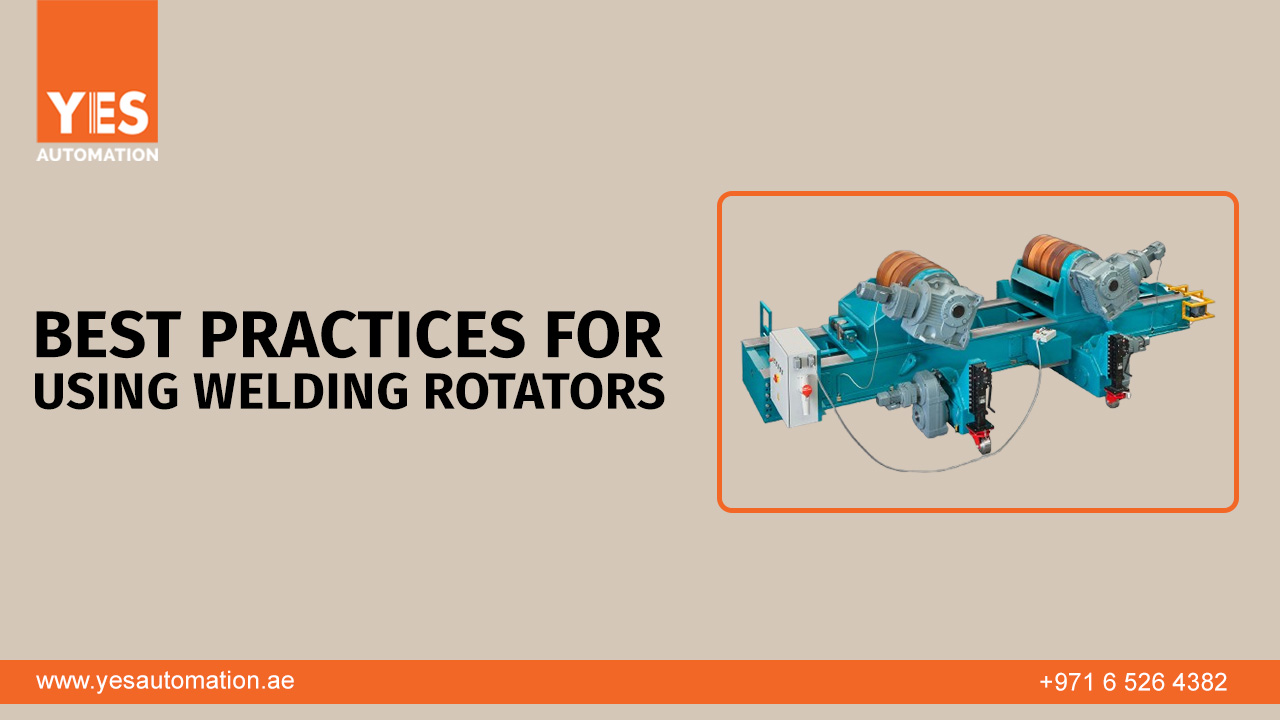Best Practices for Using Welding Rotators

Welding rotators are one of the essential tools in immense workplaces, all across the world. These equipment have an important role in increasing the welding efficiency and precision. However, safety when working with welding rotators is critical to avoiding mishaps and injury. In this blog, let’s delve into the good practices for making use of welding rotators for your jobs, with prime focus on the safety precautions that will help protect personnel and equipment.
More about Welding Rotators:
Welding rotators rotate cylindrical workpieces during welding or manufacturing. They comprise of rollers or wheels that support and spin the jobpiece, resulting in more uniform welding and increased output. Welding rotators are mostly utilized in workshops for numerous applications, such as tank fabrication jobs, pipe welding,and vessel manufacturing.
What are the Safety Measures to be Adopted While Using Welding Rotators?
Proper Training: Before operating welding rotators, all operators involved should have extensive training in equipment operation, safety protocols, and hazard awareness. The training provided is intended to include various topics related to welding rotators such as emergency procedures, loading and unloading workpieces, machine setup and emergency procedures.
1. Equipment Inspection
The welding rotators should be inspected fully before and after each and every time to make sure they are in proper working condition. You are also supposed to check for any damage and if found, proper evidence has to be collected and recorded. The working condition of rollers, driving systems and bearings have to be checked properly. In order to avoid any mishap, proper maintenance has to be done when an error is identified.
2. Secure Workpieces
Make sure the workpiece is firmly kept and positioned on the welding rotator before the start of the process. To prevent the workpiece from moving or being unstable during rotating, you need to put in the proper fixtures, clamps or other supports. In order to retain the quality of welding and prevent any kind of accidents, its very important to have a proper alignment
3. Load Capacity Awareness
Keep in mind the welding rotator's load capacity and never let it go beyond the designated limitations. There are chances that the machine's parts could be strained from overloading, which could lead to the structural damage or any other mechanical failure. For any information on the load capacity ratings, check the manuals from the manufacturer and follow them without any fail.
4. Regulate the Rotation Speed
The speed of rotation of the welding rotators can be adjusted to suit the requirements of the welding process and the workpiece properties. There are chances that enhanced rotation speed may compromise the safety, security and quality of the welded parts from any vibration or instability. For maximum performance as well as stability, it’s recommended to set the proper speed.
5. Maintain Clear Work Areas
To ensure safety in operation, maintain the surroundings of the workspace and the welding rotator neat and out of obstacles. Keep away any tools, dirt or other anything that might impede the movement of the equipment or present trip hazards. You need to ensure that there is sufficient space for employees to reach controls and take care of their jobs safely.
6. Use Personal Protective Equipment (PPE)
Operators working with a welder rotator should wear the proper PPE which includes safety helmets, safety goggles, gloves and clothing that can withstand flames. PPE lessens the possibility of getting hurt from any sparks during welding, arc radiation and any other welding-related hazards.
7. Emergency Procedures
It’s important to clearly mark emergency protocols and procedures for handling any unfortunate situations that arise during the use of the equipment, broken equipment and other unforeseen events. Make sure that every employee is well aware of evacuation exits and routes, emergency shutdown process, and first aid guidelines. Conduct proper training and drills regularly to strengthen the readiness and on safety awareness.
8. Regular Maintenance
It’s imperative to have a very proactive program for upkeep that helps the welding rotators be safe and dependable all the time. Follow the manufacturer's recommendations for routine inspections, lubrication, and adjustments. Quickly resolve any problems or irregularities to avoid downtime and ensure safe functioning.
9. Continuous Monitoring
Welding activities performed with welding rotators should be watched closely for any failure, overheating or any risks related to safety. You need to motivate your employees to rapidly report any issues or findings that arise regarding the equipment operation or any hazards related to safety.
Welding Rotators - Features
Welding Rotators typically include the following features:
- Rotational Capability: During welding or fabrication operations, welding rotators are made to revolve cylindrical workpieces, such as pipes, tanks, or vessels. They ensure that the workpiece rotates consistently, which promotes uniform welding and increases production.
- Adjustable Rotation Speed: Numerous welding rotators enable users to modify the rotation speed in accordance with the workpiece's properties and the welding process' requirements. This feature makes it possible for operators to efficiently adjust the welding conditions and attain the best possible welding results.
- Load Capacity: Welding rotators are designed to offer support to a vast variety of job pieces of varying dimensions and weights. Load capacity ratings show the maximum load that can be supported safely by welding rotators. It’s very crucial to choose the welding rotators that come with the right loading capacity in order to make sure the operation is done safely and effectively.
- Roller Configuration: The workpiece is supported and rotated by rollers or wheels on welding rotators. The geometry of the workpiece and the particular application may affect the roller configuration. Self-aligning or adjustable rollers are common roller setups that guarantee correct alignment and support while rotating.
- Drive Mechanisms: The drive mechanisms will facilitate the rotating of job pieces by the welding rotators. Depending on the model and manufacturer, these drive methods could be hydraulic, gearbox, or motorized. For the workpiece to rotate smoothly and consistently, the driving systems need to be strong and dependable.
- Control Panel: Control panels facilitate changing the speed of rotation of the welding rotators in addition to direction and other settings. For easier operation, the control panel may have switches, buttons, and digital displays. For extra convenience, some more sophisticated models could also have remote control capabilities.
Conclusion
When employing the welding rotators in your workshops or any other industrial setting, safety should be given the first priority. You can reduce the chance of mishaps, injuries, and equipment damage by adhering to the above-mentioned recommended practices and encouraging a culture of safety awareness. At YES Automation, we focus on giving proper equipment training including the features and functionalities along with the knowledge for inspection of the welding rotator, load bearing capacity and on the importance of practicing the following safety regulations.



